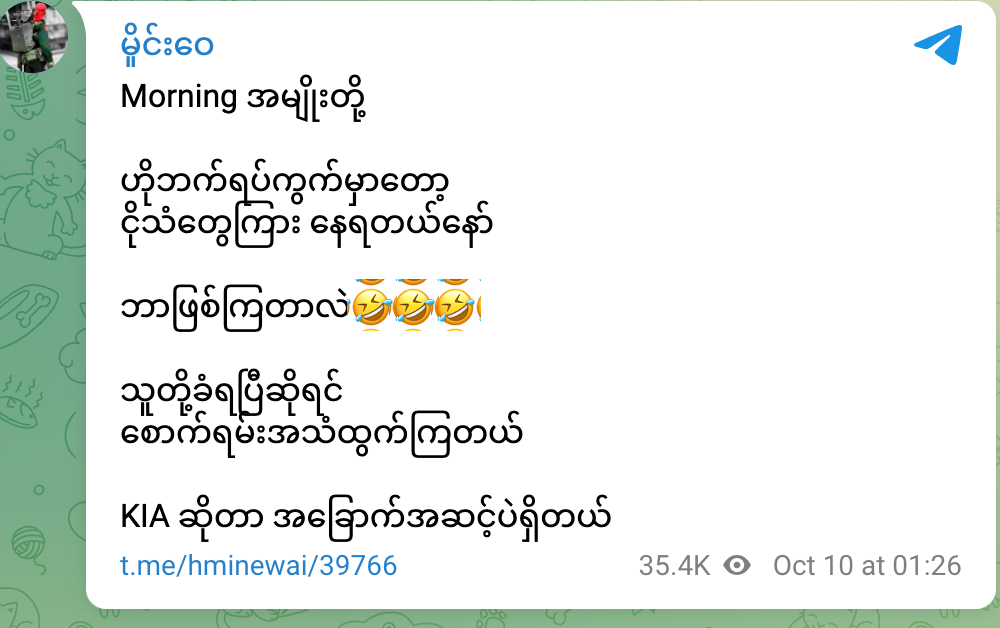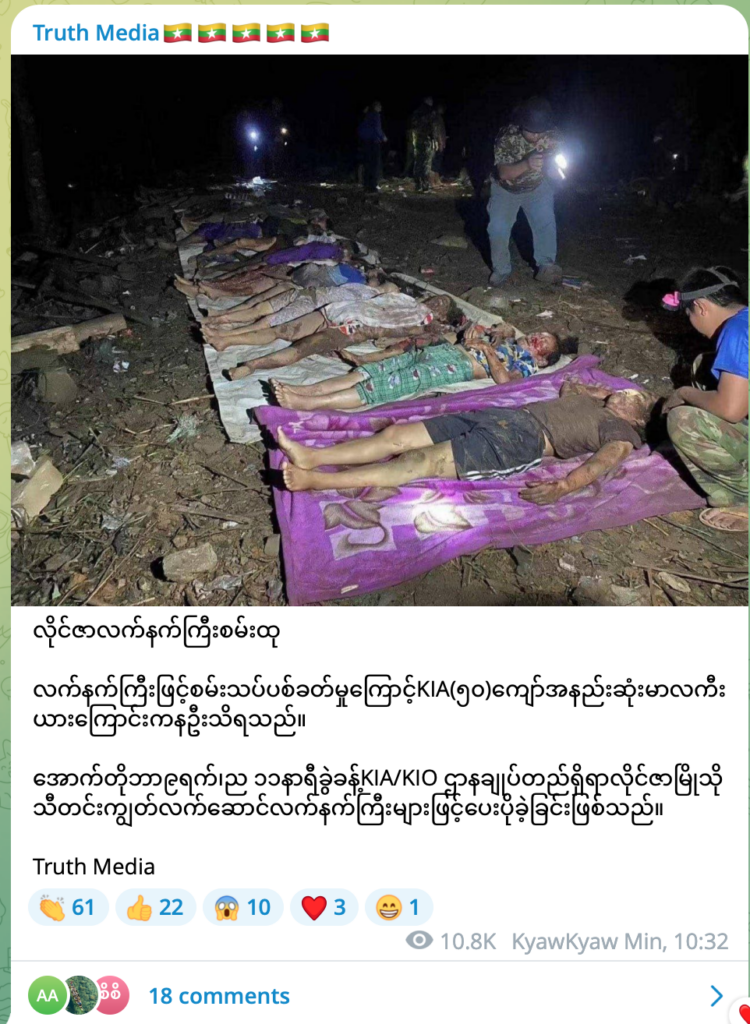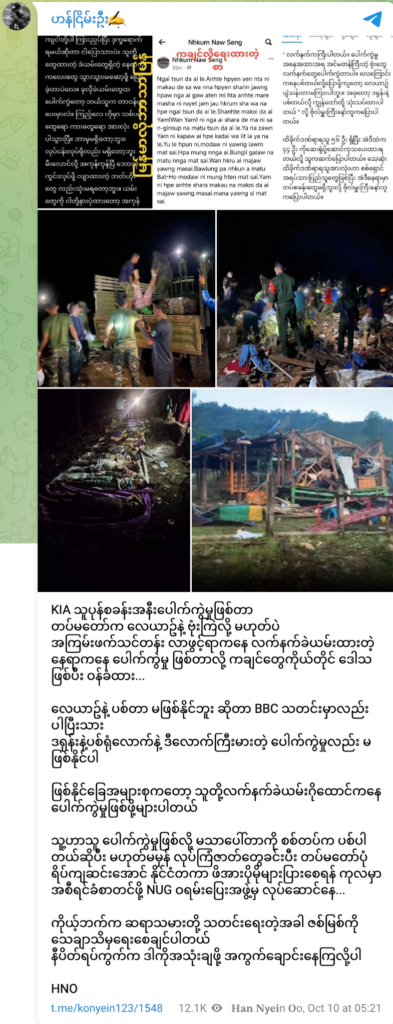Munglai Hkyet’s lost attack
At the onset of the incident, military lobby Telegram channels expressed satisfaction, suggesting the army’s involvement in the attack. However, subsequent statements from the Military’s spokesperson contradicted these claims, denying any responsibility. The reversal of the narrative was documented by SAC lobby Telegram channels.
Process
On October 9th, at approximately midnight (11:30 PM), the Munglai Hkyet military evacuation camp near Laiza city in Kachin State came under attack by heavy weaponry. The assault resulted in a devastating explosion, claiming the lives of 29 individuals and leaving 57 others injured. Among the casualties were 11 children under the age of 16 and 15 women, including some who were in a state of sedation. Additionally, a preschool and around 10 homes were destroyed in the attack. Eyewitness accounts describe the impact of the explosion, with one survivor noting the extensive damage caused to the surrounding area, including collapsed structures and disrupted landscapes, according to the Myit Kyi Na Journal.

Eyewitnesses, survivors from the refugee camp, directly implicated the coup military in the mass killing of individuals fleeing the conflict, attributing the destruction to the military’s powerful weaponry. Despite international human rights groups and KIA officials presenting expert studies confirming the use of military weapons, the military vehemently denied any involvement in the attack.
Monitoring military lobby accounts on Telegram, The Red Flag discovered initial reports indicating an “air attack by the military” in Monlaike on October 10th, with some channels expressing satisfaction over the incident, suggesting it was retaliation against KIO/KIA. However, following General Zaw Min Tun’s denial, the narrative shifted to claim the explosion originated from a KIA armory.
Further investigation revealed attempts to suppress the dissemination of information implicating the military, with directives to remove posts and avoid misleading the public about the arsenal explosion. Subsequently, the military lobby escalated the campaign by framing the incident as dissatisfaction among the Kachin people, transforming it into a racially charged narrative.
In light of these findings, The Red Flag presents this case study to highlight the manipulation of information and the dangerous propagation of divisive narratives by military lobbies.

Process
The village of Munglai Hkyet located approximately 2 miles north of Laiza, serves as a vital communication hub with China and has been established for over 40 years. Since 2011, amidst renewed conflict between the army and the Kachin state, Munglai Hkyet has become a refuge for many, including residents from Wyandmao Township, leading to an expansion of its housing capacity from around 50 to over 100 houses. The Munglai Hkyet refugee camp, comprising more than 20 barracks accommodating four groups of refugee families each, provided shelter to over 600 war refugees before it was tragically attacked and destroyed according to the BBC.
On the night of October 9th, while residents were asleep, Munglai Hkyet was rocked by powerful weapon explosions, resulting in a devastating loss of life. A rescue worker at the scene described the impact, stating that “almost all households within 300 meters of the bomb’s impact site” suffered casualties. Among the victims were a one-month-old girl, five boys aged between 3 and 10 years, six young women, and seventeen individuals aged between 30 and 70, resulting in 29 fatalities and nearly 60 injuries. The attack left the Munglai Hkyet military evacuation camp severely damaged, marking a tragic and catastrophic event for the community.
2. Step-by-step distribution model from military lobby accounts
Regarding the bombing of Munglai Hkyet, it can be observed that the military and the military lobby channels are spreading fake news.
(a) The military releases joyous attacks as a weekend gift
Starting on the morning of October 10th, just hours after the incident, at least five military lobby channels began broadcasting fake news in a manner suggesting endorsement and celebration by the military. Misinformation began to spread.
Launched on October 10th at 01:26 by Hmine Wai Channel.

Released on October 10th (01:48) by Kyaw Swar Channel

Released on October 10th (02:17) from Yan Gyi Aung account

Shared by Snow Queen Telegram Channel on October 10th at 3:58 am


(b) Dissemination that is not done by the military
At the outset, it appeared as though the military was taking action. Consequently, the KIA initially portrayed itself as being targeted. However, the narrative evolved.”
“It was observed that the Hmaine Wai channel began disseminating information at 1:35 a.m. on October 10th, with subsequent changes occurring gradually.” Archive á  Archive



On the morning of October 10th at 05:21, the Han Nyein Oo channel commenced broadcasting, featuring content seemingly authored by a Kachin individual in the Kachin language. This was accompanied by a cautionary message directed at military lobby channels, urging vigilance in their dissemination of information regarding the military.

(c) Dissemination of ammunition stored by KIA
After that, in the following days, the author revealed that the ammunition stockpiled by KIA had exploded, and on October 11th, it was found that the Kachin people were being threatened.

(d) Propaganda of religious/racial orientation
Initially, the army acted and published that the KIA had been wounded. After that, it was changed and released that it was a KIA ammunition explosion. Not only that but in the later days, it is seen that it has been shaped and spread in the form of religion and ethnicity as follows.


3. The military’s response to the coup
It has been observed in some media that the military began to deny responsibility for the attack on October 10th, the day after the attack. “We are still investigating. One is that we are always working to maintain stability and peace in the border region. I would like to think about whether it is possible to launch a bombardment near this border area in the middle of the night. I have already said. As for the Tatmadaw, we can fire at any headquarters that is armed and insurgent. can attack. However, we have already said that there was no attack. There are also various news stories. There are various reports about the organization itself. The military shot at the plane. The military opened fire. Tacho said that he was shooting with a large weapon, but it was vague. One thing I can say for sure is that the place where the explosion happened is the place where KIA used UAVs, then drones, then dropped drone bombs on military bases and dropped drone bombs on columns. So there was an explosion here. We are still investigating the cause of this explosion. Earlier, a KIA ammunition depot exploded near Laiza. There are some cases where he hid the news. Now, it is considered that the storage of these drone bombs may have been a site explosion, and the ground report is still being investigated,” Major General Zaw Min Tun’s statement was reported in some media on October 10. Then, on October 11 (Wednesday), two days after the attack, the military council announced the explosion of a KIA warehouse containing more than 100 tons of ammonium nitrate and weapons.

Before and after the attack on Munglai Hkyet, the military council was preparing to celebrate the 8th anniversary of the signing of the Nationwide Ceasefire Agreement (NCA) and invited the KIA to attend the ceremony.
The military council’s statement that it was the explosion of the cannon also included an invitation to attend the ceremony. (It was held on October 15)
- Arrests and Arrests
Army supporters have been campaigning to arrest those who expressed their condolences for the attack on Munglai Hkyet, and arrests have indeed been made.
(a) Motion to Arrest
If you write to misrepresent the actions of the military regarding the Munglai Hkyet incident, it appears that Han Nyein Oo’s account instigated the arrest.

(b) Actual Arrest
DVB reported that a CDM teacher from Amarapura Township, Mandalay Region was arrested after instigating his arrest. The report stated that a news agency had shared an article about the Munglai Hkyet incident.

5. Current situation
After the attack, the remaining survivors took shelter near the office of Wai Chai Yai Military Evasion Camp. They are in dire need of humanitarian aid, as reported by local aid groups in media reports.
The United States condemned the mass death resulting from the military council’s attack on the Monlaike refugee camp, following the military coup. This condemnation was echoed by France and Canada.
The British Embassy in Yangon also issued a statement expressing shock at reports of Myanmar military attacks resulting in civilian casualties.
Amnesty International has urged the United Nations Security Council to impose a broad arms embargo on Myanmar and to refer the October 9 attack to the International Criminal Court (ICC) for prosecution of those responsible.
Following the attack on Munglai Hkyet, fighting between the military troops and KIA forces, heading towards Laizaâwhere the KIA headquarters of the Kachin Independence Army is locatedâhas persisted until October 16.
Additionally, two KIA officers were killed and at least 10 civilians were injured in another bomb attack on the KIA Brigade (9) headquarters and Anantpa on the night of October 16.”
military lobby accounts; History of mentions from Telegram channels
- https://archive.ph/YnShe
- https://archive.ph/Ey9Be
- https://archive.ph/ThYD0
- https://archive.ph/UBfH6
- https://archive.ph/ENgia
- https://archive.ph/TXRzD
- Archive ááá·áº
- Archive ááá·áº
- https://archive.ph/tnUxY
- https://archive.ph/etVjU
- https://archive.ph/Qadwv
- https://archive.ph/0UpaB
- https://archive.ph/7ge6u
- https://archive.ph/pidmD
- https://archive.ph/3wNVH
- áá¯ááºááá¯ááºáááºáá±á«ááºáá½á²áá¾á¯á áá¬áá¼á±á¬áá·áºáá¼á áºááá²
- https://archive.ph/BB8K8
- https://archive.ph/JkyMJ
- https://t.me/mrtvnews/134234
- https://archive.ph/B8iuy
- https://archive.ph/alIGn
- https://archive.ph/ruBgp
Writings of some of the news outlets that recorded The Red Flag
The findings reveal several significant points:
The attack on the Munglai Hkyet military evacuation camp co-occurred with the leader of the military coup inviting ethnic forces to attend the 8th anniversary of the Nationwide Ceasefire Agreement (NCA). This juxtaposition suggests a contradiction in the military’s actions.
The attack resulted in numerous casualties, including 29 fatalities and nearly 60 injuries. The victims included people of all ages, with reports of children and infants among the deceased.
The attack in Kachin State marked the second instance of significant violence following the military coup, indicating escalating tensions and insecurity in the region.
The attack coincided with similar violence targeting a camp of the Rakhine Army (AA) in the same city, resulting in additional casualties and injuries. This suggests a broader pattern of conflict and instability affecting multiple ethnic groups in the region.
Military lobby channels were observed to have published news of the attack earlier than independent press outlets. This suggests a coordinated effort to control the narrative and potentially manipulate public perception.
Following the initial dissemination, there was a shift in the narrative, with military lobbies and spokespersons denying the military’s involvement in the attack. This attempt to distance themselves from the incident raises questions about accountability and transparency.
Concurrently, independent media outlets faced restrictions and denial of access to information, indicating attempts to control the flow of information and suppress alternative perspectives.
The Military Council later released a report asserting that the attack was not perpetrated by the military but was instead the result of an explosion at a KIA warehouse. This official stance contradicts earlier reports and highlights inconsistencies in the information provided to the public on October 11.
Furthermore, the dissemination of false information by pro-military channels extended to propagating narratives with religious and racial undertones. This manipulation of information for divisive purposes underscores the dangers of misinformation and propaganda in exacerbating social tensions.
Overall, these findings underscore the importance of critical media literacy and the need for independent, unbiased journalism in times of crisis.
Based on the attack on Munglai Hkyet, the military is spreading threats suggesting that the attack on Laiza is minimal in scale.
However, upon investigation, the account “Nhkum Naw Seng,” which posted a letter in the Kachin language regarding the attack, could not be found.
Further scrutiny by The Red Flag revealed that the account was fake, raising concerns about the authenticity of the information being disseminated.
Social media users expressing condolences for the Munglai Hkyet attack were reportedly urged to be arrested, with actual arrests being made. Additionally, reports from Myanmar Now news agency indicated that China Radio International, a media outlet owned by the Chinese government, referred to the incident as “artillery fire.”
Myanmar Witness, an organization dedicated to monitoring human rights abuses in Myanmar, verified to The Irrawaddy news agency that the images depicting the destruction around Munglai Hkyet village aligned with satellite images of refugee settlements.
Amnesty International stated that the size of the crater and the extent of damage resulting from the initial explosion were consistent with the impact of large cluster bombs, known to the Burmese military.
According to reports from the MPA news agency, military weapons experts speculated that the Russian-made SU 30 SME fighter jet, held by the Military Council, could have executed the bombing due to its high-speed capabilities, radar evasion capabilities, and accuracy.
The exact weapon used in the attack remains unknown and is currently under investigation. Despite the military denying responsibility for the attack on the Munglai Hkyet refugee camp and the subsequent casualties, eyewitnesses on the ground, military experts, some international organizations, and the KIA have pointed to the military as the perpetrator. However, conclusive evidence has yet to be uncovered. Nevertheless, the military council and military lobby channels are leveraging the Munglai Hkyet incident to disseminate misinformation, actively engaging in ethnic and religious propaganda.
Annex
The National League for Democracy (NLD) announced on October 11 that over the past two and a half years under the military council’s rule, 22 massacres occurred in seven districts and provinces across Myanmar.
According to the NLD’s statement, the massacres resulted in the deaths of 590 innocent civilians, with the highest number of casualties reported in Magwe, Sagaing, Bago, Karen, Kachin, and Mon.
Most of the massacres, totaling 14, took place in Sagaing, primarily due to airstrikes conducted by the military. In Kantbalu Township, 168 individuals lost their lives in an airstrike on Pazigyi village, while 62 people were killed in an airstrike on Anantpa village in Phakant Township, Kachin State.
In a tragic incident last year in 2022, during a music concert commemorating the 62nd anniversary of the formation of the Kachin Independence Organization (KIO/KIA) in Anantpa village, warplanes belonging to the Military Council bombed the area, resulting in the deaths of KIA officers, including a brigade commander, soldiers, artists, businessmen, and civilians.

